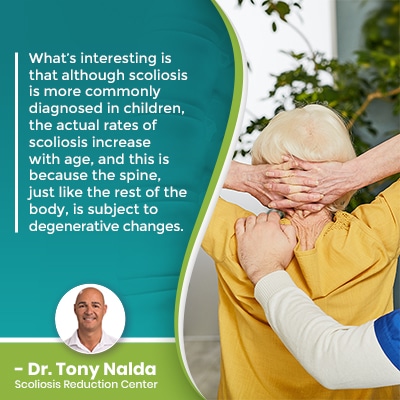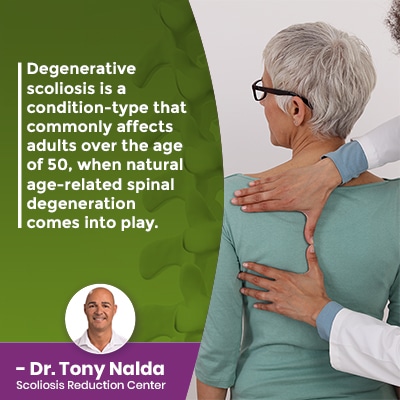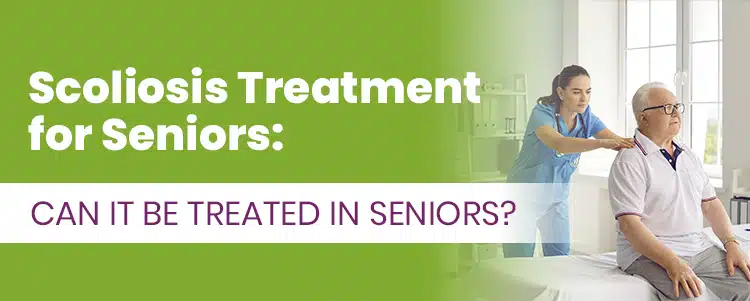As scoliosis affects all ages, we’re familiar with the unique challenges associated with treating scoliosis in different age groups. When it comes to addressing scoliosis in the aging population, the focus shifts from achieving a significant curvature reduction to reducing a scoliotic curve back to where it was before causing pain, while further stabilizing the spine.
Scoliosis affects all ages, and seniors are most affected by degenerative scoliosis, commonly diagnosed in adults over the age of 50. There are no treatment guarantees, and treating scoliosis in seniors has a different focus, but condition-improvement can be worked towards.
In addition to scoliosis ranging widely in severity, there are also different types a person can develop, with degenerative scoliosis most commonly affecting the elderly.
Different Types of Scoliosis
When scoliosis is diagnosed, part of the process involves further classifying conditions based on key patient/condition variables, one of which is condition type.
Condition type is determined by causation, and different types of scoliosis have different characteristics and treatment-needs.
The majority of known diagnosed scoliosis cases (approximately 80 percent) are classified as idiopathic, meaning not clearly associated with a single-known cause; the remaining 20 percent are associated with known causes: neuromuscular scoliosis, congenital scoliosis, and degenerative scoliosis.
Neuromuscular scoliosis is caused by the presence of a larger neuromuscular condition such as muscular dystrophy, cerebral palsy, and spina bifida.
Congenital scoliosis is a rare form, affecting approximately 1 in 10,000 babies, that’s caused by a malformed spine that develops in utero.
When it comes to seniors diagnosed with scoliosis, this most often involves the last type with a known cause: degenerative scoliosis.
Why Do Older People Get Scoliosis?

What’s interesting is that although scoliosis is more commonly diagnosed in children, the actual rates of scoliosis increase with age, and this is because the spine, just like the rest of the body, is subject to degenerative changes.
Degenerative scoliosis is commonly diagnosed in adults over the age of 50 and is caused by natural age-related spinal degeneration.
While there is a certain amount of spinal degeneration to be expected with age, lifestyle factors can affect a patient’s rate and severity of degenerative changes.
Carrying excess weight means putting more pressure on the body’s joints, including the spine and its individual structures, making it more strained, weak, and vulnerable to injury.
The spine’s design is based on movement, so leading a sedentary lifestyle is contrary to that and can contribute to spinal rigidity, weak core muscles, disc desiccation, and obesity.
Chronic poor posture, over time, can introduce adverse spinal tension and stretch the ligaments and connective tissues that support the spine, making them less capable of optimally supporting the spine’s natural curves and alignment.
In addition, excessive consumption of alcohol and/or smoking can also cause spinal degeneration by contributing to disc desiccation and impacting a person’s overall health.
For those who have careers that involve a lot of heavy lighting, repeatedly not lifting objects correctly using the legs instead of straining the back, can make the spine more vulnerable to injury and degenerative changes.
So older people get degenerative scoliosis because their spines are experiencing degenerative changes, and the cumulative effect of certain lifestyle factors also play a role.
What is Degenerative Scoliosis?
Degenerative scoliosis is a condition-type that affects adults over the age of 50, when natural age-related spinal degeneration comes into play.
In a healthy spine, its curves and alignment are in place. The spine’s healthy curves make it stronger, more flexible, and better able to handle mechanical stress incurred during activity.
With scoliosis, the development of an unnatural sideways spinal curve that also rotates, introduces a lot of uneven forces to the spine’s surrounding muscles and nerves, and the entire body.
When the spine starts to deteriorate, it’s often its intervertebral discs that are the first spinal structures to feel the effects.
The spine consists of vertebrae stacked on top of one another, and adjacent vertebrae are separated by an intervertebral disc, and these discs perform many essential roles in maintaining spinal health, strength, and function.
The discs give the spine structure (adjacent vertebrae attach to the disc in between), combine forces to facilitate flexible movement, and act as the body’s shock absorbers, so when one or more discs start to deteriorate, the entire spine can be affected.
As a disc deteriorates, it tends to become desiccated, and this causes it to change shape, lose height, and as adjacent vertebral bodies are attached to the disc in between, it will disrupt the position of those vertebrae.
If vertebral bodies shift their position out of alignment with the rest of the spine, this means an unnatural spinal curve is developing, and if the curve also twists, this is a degenerative scoliotic curve.
In all types of scoliosis, as a progressive condition, the best time to start treatment is always now, and this is particularly true in cases of degenerative scoliosis where increasing spinal instability, coupled with progression, can make the spine degenerate further.
So if an elderly person develops degenerative scoliosis, is it treatable?
Scoliosis Treatment for Elderly

Scoliosis is a progressive condition, meaning it has it in its nature to worsen over time, which is why being proactive with treatment is so important.
When spinal degeneration is also happening, the spine becomes increasingly unstable, and this disrupts its ability to maintain its natural curves and alignment.
In addition, as people age, they tend to lose muscle mass, and this means the spine’s surrounding muscles are getting weaker and are providing the spine with less and less support.
The spine degenerating as people age is the reason the actual rate of scoliosis increases in the aging population, even though it’s more commonly diagnosed in children.
When it comes to treating degenerative scoliosis, a conservative approach is non-invasive and can be fully customized to address the unique challenges associated with scoliosis treatment in seniors.
Conservative Chiropractic-Centered Scoliosis Treatment
When treating scoliosis in children, for example, monitoring for rapid-phase progression is a focus of treatment because we know that growth is the condition’s main trigger for progression; a goal of treatment is significantly reducing a scoliotic curve and holding it there, despite the constant trigger of growth.
In adults, rapid-phase progression isn’t as much of a risk, so the treatment focus can involve slowing down and working towards increasing the spine’s stability to counteract the effects of natural age-related spinal degeneration.
In seniors, a curvature reduction achieved through a series of gentle and precise manual chiropractic adjustments is still a goal of treatment, but reducing a curve back to where it was before becoming painful is the goal, and increasing spinal stabilization by increasing the spine’s surrounding supportive-muscle strength.
Through physical therapy and a series of scoliosis-specific exercises and stretches, I can help seniors increase their core strength, which means a more stable spine because it’s receiving optimal support from its surrounding muscles.
Chiropractic care can be adjusted accordingly and work towards adjusting the position of the curve’s most-tilted vertebrae so they are back in alignment with the rest of the spine.
Realigning the spine is making it more stable, and this is exactly what’s needed for effective scoliosis treatment in seniors.
I can apply corrective bracing for short-term pain management and increasing spinal stabilization during treatment, and rehabilitation involves further stabilizing and healing the spine through custom-prescribed home exercises.
Conclusion
When it comes to scoliosis treatment for seniors, the main condition-type to affect aging adults is degenerative scoliosis, and this is caused by natural age-related spinal degeneration.
In addition, the cumulative effect of certain lifestyle factors can also play a role in a person’s severity and rate of age-related spinal changes.
Degenerative scoliosis is most common in adults over the age of 50, and is also more common in females; this is thought to be related to changes in hormones and bone density caused by menopause.
The goal of degenerative scoliosis treatment is to reduce the curve back to where it was prior to becoming painful, and as the trigger of growth is removed, there is more time to work towards this treatment goal.
Through combining condition-specific chiropractic care, physical therapy, corrective bracing, and rehabilitation, condition-improvement can be worked towards that improves a patient’s quality of life throughout treatment and beyond.
Here at the Scoliosis Reduction Center®, I believe in the power of proactive treatment that works towards preventing progression and increasing spinal stability, while restoring as much of the spine’s healthy curves as possible.
In addition, while surgical treatment is always an option, spinal surgery is invasive, and the associated risks of potential side effects and complications only increase with age, so another goal of my conservative treatment approach is to help seniors avoid the need for invasive surgical treatment.




